 This paper explores the market forces leading to rising interest in non-nat cat ILS alternatives, the differences between these products and traditional nat cat ILS products, and the crucial factors institutional investors and hedge fund managers should consider when deciding whether or not to move into this space.
This paper explores the market forces leading to rising interest in non-nat cat ILS alternatives, the differences between these products and traditional nat cat ILS products, and the crucial factors institutional investors and hedge fund managers should consider when deciding whether or not to move into this space.
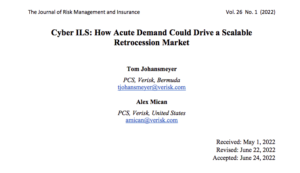 Increasing demand for cyber re/insurance and a shortage of supply have made the need for fresh risk capital acute. After years of seeking support from the insurance linked securities (ILS) market, re/insurers may be on the brink of a major change. Property Claim Services, a Verisk business, has conducted original research with 24 ILS funds representing nearly 80% of the sector as measured by assets under management. ILS appetite for cyber re/insurance risk has increased, with many funds interested in entering the market this year. Historical barriers such as structure and modeling may not be as problematic as they were in the past, and narrowing spreads on cyber ILS have made the risk more attainable for providers of collateralized protection. Market dynamics have pushed pricing to levels that ILS funds can reasonably contemplate, which means that scale may soon follow.
Increasing demand for cyber re/insurance and a shortage of supply have made the need for fresh risk capital acute. After years of seeking support from the insurance linked securities (ILS) market, re/insurers may be on the brink of a major change. Property Claim Services, a Verisk business, has conducted original research with 24 ILS funds representing nearly 80% of the sector as measured by assets under management. ILS appetite for cyber re/insurance risk has increased, with many funds interested in entering the market this year. Historical barriers such as structure and modeling may not be as problematic as they were in the past, and narrowing spreads on cyber ILS have made the risk more attainable for providers of collateralized protection. Market dynamics have pushed pricing to levels that ILS funds can reasonably contemplate, which means that scale may soon follow. 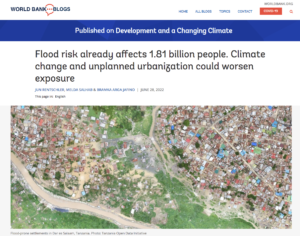 Flooding is among the leading climatic threats to people’s livelihoods, affecting development prospects worldwide – and floods can also reverse years of progress in poverty reduction and development. While the threat is already substantial, climate change and rapid urbanization in flood zones are likely to further drive up flood risks. The latest Intergovernmental Panel on Climate Change report affirms the urgency of addressing the intensifying impacts of climate change and ensuring the adaptation and resilience of the most vulnerable.
Flooding is among the leading climatic threats to people’s livelihoods, affecting development prospects worldwide – and floods can also reverse years of progress in poverty reduction and development. While the threat is already substantial, climate change and rapid urbanization in flood zones are likely to further drive up flood risks. The latest Intergovernmental Panel on Climate Change report affirms the urgency of addressing the intensifying impacts of climate change and ensuring the adaptation and resilience of the most vulnerable.
In October 2020, we presented a working paper that offered insight into global flood risk exposure and its intersection with poverty. Now, using updated state-of-the-art flood data, our analysis just published in Nature Communications, estimates that 1.81 billion people face significant flood risk worldwide, substantially higher than the 1.47 billion estimated in our initial study. Our updated study uses more accurate data on fluvial, pluvial, and coastal hazards, as well as subnational poverty. It also estimates that 170 million extremely poor people are facing flood risk and its devastating long-term consequences. Together, these findings provide alarming insights into the scale of people’s exposure and their vulnerabilities to flood hazards. A few of our key findings:
 Financial losses from natural disasters continue to rise, with developing countries and their low-income populations feeling the greatest effects. Weather-related losses and damages alone have risen from an annual average of about $50 billion in the 1980s to close to $200 billion over the last decade. Climate change could potentially push 100 million more people back into poverty over the next 15 years. The less visible financial impact on the poorest is often the most detrimental and persistent. This can include lifelong and irreversible harm such as loss of access to education or stunting from malnutrition. The cost of disasters does not have to be so devastating. Proactive financial planning can help countries protect livelihoods and investments. Financial protection policies and instruments can support Governments to act as effective risk managers, rather than emergency borrowers. These innovative learning modules provided by the Disaster Risk Financing and Insurance Program (DRFIP)—a partnership of the World Bank Group and the Global Facility for Disaster Reduction and Recovery (GFDRR)—seek to provide Ministers of Finance and their development partners with information and approaches needed to appropriately plan for and manage the financial impact of disasters. The DRFIP is a leading partner of developing countries looking to develop and implement comprehensive financial protection strategies that reduce the financial risk posed by disasters and climate change.
Financial losses from natural disasters continue to rise, with developing countries and their low-income populations feeling the greatest effects. Weather-related losses and damages alone have risen from an annual average of about $50 billion in the 1980s to close to $200 billion over the last decade. Climate change could potentially push 100 million more people back into poverty over the next 15 years. The less visible financial impact on the poorest is often the most detrimental and persistent. This can include lifelong and irreversible harm such as loss of access to education or stunting from malnutrition. The cost of disasters does not have to be so devastating. Proactive financial planning can help countries protect livelihoods and investments. Financial protection policies and instruments can support Governments to act as effective risk managers, rather than emergency borrowers. These innovative learning modules provided by the Disaster Risk Financing and Insurance Program (DRFIP)—a partnership of the World Bank Group and the Global Facility for Disaster Reduction and Recovery (GFDRR)—seek to provide Ministers of Finance and their development partners with information and approaches needed to appropriately plan for and manage the financial impact of disasters. The DRFIP is a leading partner of developing countries looking to develop and implement comprehensive financial protection strategies that reduce the financial risk posed by disasters and climate change.
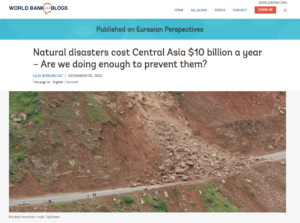 When starting my assignment in Central Asia four years ago, my introductory briefing included a map of the region that showed the incidence of earthquakes in the previous 30 days. I was shocked at the number of red dots all over the map. Yet earthquakes are not the only hazard: Central Asia is also prone to landslides, floods, mudflows, droughts, avalanches, and extreme temperatures. These natural disasters lead, on average, to an astounding $10 billion in estimated economic losses every year.
When starting my assignment in Central Asia four years ago, my introductory briefing included a map of the region that showed the incidence of earthquakes in the previous 30 days. I was shocked at the number of red dots all over the map. Yet earthquakes are not the only hazard: Central Asia is also prone to landslides, floods, mudflows, droughts, avalanches, and extreme temperatures. These natural disasters lead, on average, to an astounding $10 billion in estimated economic losses every year.
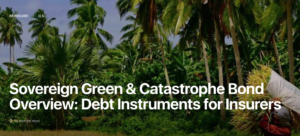 Catastrophe and green bonds in the private sector have become the most prominent innovations in the field of sustainable finance in the last 15 years.
Catastrophe and green bonds in the private sector have become the most prominent innovations in the field of sustainable finance in the last 15 years.
 This study examines the relationship between Cat Bonds market and the other financial markets. Precisely, cointegration tests (the Engle and Granger’s methodology) were applied on weekly data of five indexes over the period 2012- 2019 to test for the existence of a long-run dynamic equilibrium relationship between Cat Bonds market and four financial markets, namely, Insurance Linked Securities (ILS) market, S&P 500 (first stock market), MSCI (second stock market) and Corporate Bonds market. In addition, a comparative analysis correlation vs cointegration was conducted to verify whether Cat Bonds can be really considered as zero-beta assets in the short-run (correlation) as well as the long-run (cointegration). For correlation analysis we employed three correlation coefficients (Pearson’s Correlation Coefficient, Spearman’s Rank Correlation Coefficient and Kendall’s Rank Correlation Coefficient). Overall, the main findings of this study showed that in the short-run, Cat Bonds are partially zero-beta assets while over the long-run they are entirely zero-beta assets. Such results will be of great importance for investors in their decision choice between a short strategy or a long strategy in Cat Bonds’ investing.
This study examines the relationship between Cat Bonds market and the other financial markets. Precisely, cointegration tests (the Engle and Granger’s methodology) were applied on weekly data of five indexes over the period 2012- 2019 to test for the existence of a long-run dynamic equilibrium relationship between Cat Bonds market and four financial markets, namely, Insurance Linked Securities (ILS) market, S&P 500 (first stock market), MSCI (second stock market) and Corporate Bonds market. In addition, a comparative analysis correlation vs cointegration was conducted to verify whether Cat Bonds can be really considered as zero-beta assets in the short-run (correlation) as well as the long-run (cointegration). For correlation analysis we employed three correlation coefficients (Pearson’s Correlation Coefficient, Spearman’s Rank Correlation Coefficient and Kendall’s Rank Correlation Coefficient). Overall, the main findings of this study showed that in the short-run, Cat Bonds are partially zero-beta assets while over the long-run they are entirely zero-beta assets. Such results will be of great importance for investors in their decision choice between a short strategy or a long strategy in Cat Bonds’ investing.
We investigate the feasibility of cyber risk transfer through insurance-linked securities (ILS). On the investor side, we elicit the preferred characteristics of cyber ILS and the corresponding return expectations. We then estimate the cost of equity of insurers and compare it to the Rate on Line expected by investors to match demand and supply in the cyber ILS market. Our results show that cyber ILS will work for both cedents and investors if the cyber risk is sufficiently well understood. Thus, challenges related to cyber risk modeling need to be overcome before a meaningful cyber ILS market may emerge.
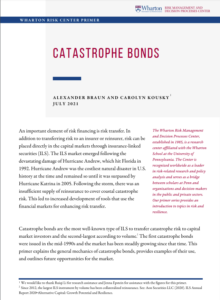 The first catastrophe bonds were issued in the mid-1990s and the market has been steadily growing since that time. The most recent Risk Center Primer, by Alexander Braun and Carolyn Kousky, explains the general mechanics of catastrophe bonds, provides examples of their use, and outlines future opportunities for the market. 10 Pages.
The first catastrophe bonds were issued in the mid-1990s and the market has been steadily growing since that time. The most recent Risk Center Primer, by Alexander Braun and Carolyn Kousky, explains the general mechanics of catastrophe bonds, provides examples of their use, and outlines future opportunities for the market. 10 Pages.
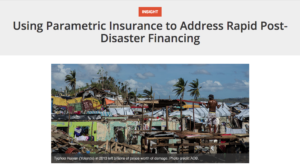 Gaps in response funding immediately after disaster can now be addressed through a new form of insurance.
Gaps in response funding immediately after disaster can now be addressed through a new form of insurance.
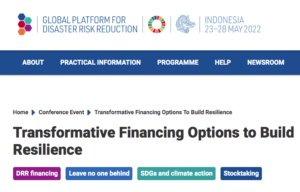 Societies continue to bear increasing costs from natural hazards as population growth, the geographic concentration of economic and infrastructural assets in vulnerable areas, and the effects of climate change are accelerating exposure to potential losses.
Societies continue to bear increasing costs from natural hazards as population growth, the geographic concentration of economic and infrastructural assets in vulnerable areas, and the effects of climate change are accelerating exposure to potential losses.
The financial losses from disasters are a systemic financial risk. They cascade through the financial system, with capital flight from vulnerable sectors and communities, sovereign credit risk, sovereign defaults, sudden and sharp write downs from devaluation and insurance premiums. This can create new risks and/or reinforce existing inequalities. Ultimately, they challenge the ability to raise investment to increase resilience.
Resilience requires a layered financial strategy bringing to bear all sources of financing and risk prevention projects need to draw on all potential beneficiaries for funding. Innovative financing models such as blended finance and impact investing have emerged as tools for addressing risks and encouraging the private investments that can transform people’s lives and contribute toward Sendai Framework implementation. This session will discuss and explore the implementation and scale-up of innovative market-driven products and options for the financing of resilience.
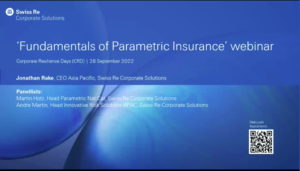 The effects of climate change are becoming more evident. Seoul, South Korea recently experienced severe flood damage following the heaviest rainfall in over 100 years. New South Wales in Australia has been hit by major floods several times this year. Swiss Re Institute noted 306 catastrophe events last year. These events had economic losses amounting to USD 280 billion, of which USD270 billion are attributed to economic losses arising from natural catastrophes. There were more than 50 severe flood events around the world in 2021, resulting in combined economic losses of more than USD 80 billion. Of this 80 billion, only USD 20 billion were insured losses. This signifies the large global protection gap that still exists.
The effects of climate change are becoming more evident. Seoul, South Korea recently experienced severe flood damage following the heaviest rainfall in over 100 years. New South Wales in Australia has been hit by major floods several times this year. Swiss Re Institute noted 306 catastrophe events last year. These events had economic losses amounting to USD 280 billion, of which USD270 billion are attributed to economic losses arising from natural catastrophes. There were more than 50 severe flood events around the world in 2021, resulting in combined economic losses of more than USD 80 billion. Of this 80 billion, only USD 20 billion were insured losses. This signifies the large global protection gap that still exists.
The combination of the impact from climate change impacts and the increasing global protection gap signals the need for the insurance industry to increase the resilience of businesses.
Innovative solutions such as parametric insurance is a means for companies to enhance their resilience.
Tune in to this webinar recording as APAC CEO Jonathan Rake hosts experts Martin Hotz, Head Parametric Nat Cat, and Andre Martin, Head Innovative Risk Solutions APAC, in an engaging discussion around the fundamentals of parametric insurance, how parametric works in practice, and execution of parametric insurance in the Asia Pacific region, and the way forward.
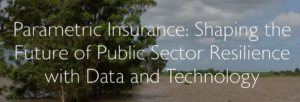 When discussing parametric insurance and its value to public entities, the conversation often involves innovative features of parametric products – speed, flexibility, and transparency. However, what makes parametric insurance valuable is as much the insurance aspect as its parametric qualities. With increased granularity and ubiquity of data coupled with advancements in technology, parametric insurance can reshape how the public sector accesses insurance.
When discussing parametric insurance and its value to public entities, the conversation often involves innovative features of parametric products – speed, flexibility, and transparency. However, what makes parametric insurance valuable is as much the insurance aspect as its parametric qualities. With increased granularity and ubiquity of data coupled with advancements in technology, parametric insurance can reshape how the public sector accesses insurance.
To understand why parametric insurance is valuable to public entities, it is important to reflect on the motivation of public entities to purchase insurance and the gaps in the traditional programs they intend to fill. This big picture view highlights the efficacy of insurance to address the widening protection gap (See: Closing the protection gap | Swiss Re), especially when it comes to losses driven by climate change. Parametric products leverage data and technology to reshape the value of insurance and provide a mechanism to meet the growing needs of governments and communities.
This was the third session of the day from our Artemis London 2022 conference, held on September 6th, 2022.
The event was Artemis’ first insurance-linked securities (ILS) conference held in the City of London and saw more than 240 attendees enjoy a wide-range of sessions and networking opportunities.
Themed largely around the catastrophe bond, attendees heard from expert speakers that have been in the sector for years, as well as newcomers with ideas of how to innovate the cat bond and ILS market going forwards.
Attendees came from as far afield as New Zealand, Hawaii, Asia, North and South America, Bermuda, as well as a large European contingent, plus as you’d expect numerous London marketplace leaders in ILS and reinsurance.
This third video from the event features a panel discussion on environmental, social and governance (ESG) trends in the catastrophe bond market, under the title of “ESG in the cat bond market. Where next?”, moderated by Dirk Schmelzer, Partner, Senior Portfolio Manager, Plenum Investments AG.
Panellists participating in this discussion were: Chantal Berendsen, Hedge Fund IDD Senior Analyst, Insurance Specialist, Albourne Partners; Siti Dawson, Executive Director, LGT ILS Partners; and Andy Palmer, Head ILS Structuring EMEA & APAC / CEO SRCML, Swiss Re.
The group discussed how ESG has increased as a priority with cat bond and ILS investors, what the ILS market is doing to respond to investors ESG needs and where the catastrophe bond market goes next on its journey towards becoming increasingly ESG appropriate as an asset class.
Andy Palmer of Swiss Re commented on the current status of ESG in reinsurance and ILS, “I think we’re towards the beginning of the discussion. Different sponsors are on different journeys, generally as a company. They’re still trying to understand what sustainability means to them as a business. It’s very early days, but at least heading in the right direction.”
Siti Dawson of LGT ILS Partners explained the motivations driving initiatives to deliver on greater ESG related standardisation within the ILS industry, “For our investor-base, it would be a great help to know what in terms of ESG data they are getting for their money. Of course the lack of standardisation is a big topic, but on the other hand a big opportunity for us, us being the ILS industry, to work towards at least some form of standardisation.”
Chantal Berendsen, of Albourne Partners, added the view of an investment advisory, “Even if it starts with a yes/no just to understand what’s in the portfolio and get people used to providing more information. It’s the direction of travel that’s really positive.”
Dirk Schmelzer, of Plenum Investments, highlighted that this mission to add greater ESG appropriateness to the cat bond and ILS asset class is also investor-driven, to a degree, “Ultimately, you’re looking for standardisation, when you talk about ESG, instead of having a highly fragmented, opinion-driven environment, that you need to navigate. I think standardisation may also be helpful in communicating back to our investors.”
Watch the full video for more of their comments.
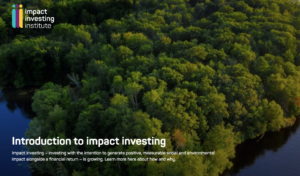 So, what is impact investing? This module provides the answer and places impact investing in the context of traditional, responsible and sustainable investing. The module also introduces the ‘spectrum of capital’ – a vital aid in explaining impact investing to others – and gives a briefing on the development of impact investing over time and the key global frameworks and standards that govern the market. It also acknowledges some of the challenges that impact investing is addressing as well as the opportunities that are ahead. This section provides the foundational knowledge that you need before you can build your impact skills and expertise.
So, what is impact investing? This module provides the answer and places impact investing in the context of traditional, responsible and sustainable investing. The module also introduces the ‘spectrum of capital’ – a vital aid in explaining impact investing to others – and gives a briefing on the development of impact investing over time and the key global frameworks and standards that govern the market. It also acknowledges some of the challenges that impact investing is addressing as well as the opportunities that are ahead. This section provides the foundational knowledge that you need before you can build your impact skills and expertise.
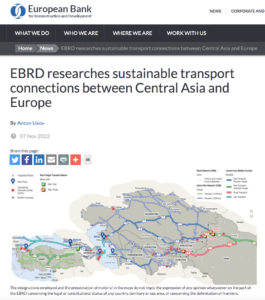 As trade volumes, particularly container traffic, between Asia and Europe continue to grow and as geopolitical events disrupt existing trade corridors, major trading and logistics companies are exploring ways to diversify and optimise transport routes and make them more sustainable.
As trade volumes, particularly container traffic, between Asia and Europe continue to grow and as geopolitical events disrupt existing trade corridors, major trading and logistics companies are exploring ways to diversify and optimise transport routes and make them more sustainable.
The European Bank for Reconstruction and Development (EBRD) is conducting a study on sustainable transport connections between Central Asia and Europe, funded by the European Commission. The study, which should be completed by summer 2023, aims to identify the most sustainable transport connections between Central Asian economies and the extended Trans-European Transport Network (TEN-T).
It has two objectives: to identify the most sustainable transport corridors connecting the five Central Asian countries with the European Union’s TEN-T, including the Caucasus, and to propose actions for their development, including actual infrastructure investments and the necessary enabling environment.
We examine whether CAT bonds can serve as a hedge or a safe haven for global stock, bond, real estate, commodity, private equity, and infrastructure markets. Our results indicate that CAT bonds are a poor hedge, but they act as an effective diversifier against all asset classes under investigation. Moreover, CAT bonds can serve as a strong safe haven against extreme price drops of stocks only during the post-crisis period.
The P/C Extreme Events and Property Lines Committee produced this issue paper on insurance-linked securities and catastrophe bonds to inform and educate key audiences including actuaries, insurance stakeholders, and public policy decision-makers.
Catastrophe bonds (cat bonds)1 are a subset of insurance-linked securities (ILS), which are debt-like investment instruments providing risk coverage to insurance and reinsurance entities. ILS are principally funded by funds from investors and supplemented by the “insurance premium” paid by the entity obtaining the risk protection (cedant). The insurance or risk premium paid by the cedant works to enhance the yield on these investments.
The capital markets are significantly larger than the (re)insurance market and can more easily accommodate losses from extremely large insured events, benefiting entities seeking risk coverage. At the same time, cat bonds provide investors with potentially higher yield returns on investment generally thought to have little to no correlation with other capital markets.
Cat bonds may be utilized by both insurers and self-insureds, including governments, with the particular needs of the sponsors affecting the structure that the bonds take.
ILS instruments (excluding Mortgage ILS deals) have grown to $14 billion issued during 2021, with $36 billion outstanding. Nearly all (96%) of the $14 billion were cat bonds.
The issue paper describes and explains major components of ILS/cat bonds and concludes with an illustrative example.
The Fundamentals of Insurance-Linked Securities (ILS) is an online professional qualification upgrade course and in-person Swiss summer school convened by Phoenix CRetro Ltd. in partnership with various professional and educational institutions worldwide.
| Cookie | Duration | Description |
|---|---|---|
| cookielawinfo-checbox-analytics | 11 months | This cookie is set by GDPR Cookie Consent plugin. The cookie is used to store the user consent for the cookies in the category "Analytics". |
| cookielawinfo-checbox-functional | 11 months | The cookie is set by GDPR cookie consent to record the user consent for the cookies in the category "Functional". |
| cookielawinfo-checbox-others | 11 months | This cookie is set by GDPR Cookie Consent plugin. The cookie is used to store the user consent for the cookies in the category "Other. |
| cookielawinfo-checkbox-necessary | 11 months | This cookie is set by GDPR Cookie Consent plugin. The cookies is used to store the user consent for the cookies in the category "Necessary". |
| cookielawinfo-checkbox-performance | 11 months | This cookie is set by GDPR Cookie Consent plugin. The cookie is used to store the user consent for the cookies in the category "Performance". |
| viewed_cookie_policy | 11 months | The cookie is set by the GDPR Cookie Consent plugin and is used to store whether or not user has consented to the use of cookies. It does not store any personal data. |